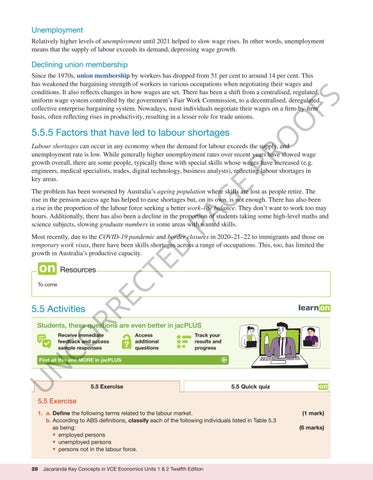“c05TheChangingLabourMarket_PrintPDF” — 2022/6/3 — 13:15 — page 28 — #28
Unemployment Relatively higher levels of unemployment until 2021 helped to slow wage rises. In other words, unemployment means that the supply of labour exceeds its demand, depressing wage growth.
Declining union membership
O
FS
Since the 1970s, union membership by workers has dropped from 51 per cent to around 14 per cent. This has weakened the bargaining strength of workers in various occupations when negotiating their wages and conditions. It also reflects changes in how wages are set. There has been a shift from a centralised, regulated, uniform wage system controlled by the government’s Fair Work Commission, to a decentralised, deregulated, collective enterprise bargaining system. Nowadays, most individuals negotiate their wages on a firm-by-firm basis, often reflecting rises in productivity, resulting in a lesser role for trade unions.
O
5.5.5 Factors that have led to labour shortages
E
PR
Labour shortages can occur in any economy when the demand for labour exceeds the supply, and unemployment rate is low. While generally higher unemployment rates over recent years have slowed wage growth overall, there are some people, typically those with special skills whose wages have increased (e.g. engineers, medical specialists, trades, digital technology, business analysts), reflecting labour shortages in key areas.
PA
G
The problem has been worsened by Australia’s ageing population where skills are lost as people retire. The rise in the pension access age has helped to ease shortages but, on its own, is not enough. There has also been a rise in the proportion of the labour force seeking a better work–life balance. They don’t want to work too may hours. Additionally, there has also been a decline in the proportion of students taking some high-level maths and science subjects, slowing graduate numbers in some areas with wanted skills.
Resources
Resourceseses
CO RR EC
To come
TE
D
Most recently, due to the COVID-19 pandemic and border closures in 2020–21–22 to immigrants and those on temporary work visas, there have been skills shortages across a range of occupations. This, too, has limited the growth in Australia’s productive capacity.
5.5 Activities
Students, these questions are even better in jacPLUS Receive immediate feedback and access sample responses
Access additional questions
Track your results and progress
U
N
Find all this and MORE in jacPLUS
5.5 Exercise
5.5 Quick quiz
5.5 Exercise 1. a. Define the following terms related to the labour market. b. According to ABS definitions, classify each of the following individuals listed in Table 5.3 as being: • employed persons • unemployed persons • persons not in the labour force.
28
Jacaranda Key Concepts in VCE Economics Units 1 & 2 Twelfth Edition
(1 mark) (6 marks)





















































